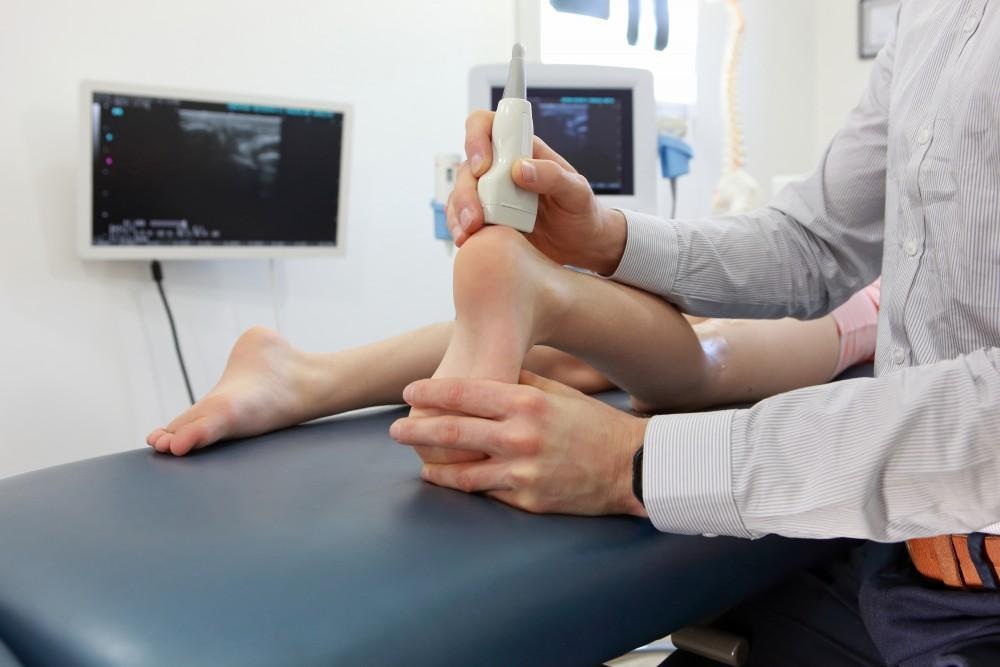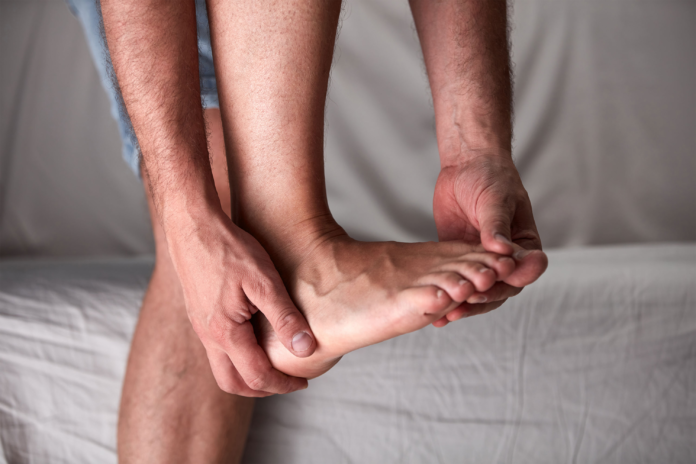Foot pain is a common woe—a dull throb or a sharp sting that can disrupt even the most mundane walk. But beyond the immediate discomfort, repeatedly stubbing your feet can signal underlying issues contributing to these painful missteps. This guide explores the connection between stubbed toes and various foot pain symptoms, helping you understand what your foot might be trying to tell you.
Symptoms of Foot Pain
Foot pain isn’t just a one-size-fits-all ache. It can manifest as a dull throb in your heel, a sharp toe sting, or a general discomfort. This discomfort can extend to the edges and arch of your foot and might be accompanied by swelling, redness, rough patches, or even lumps and bumps. If you’re experiencing any of these symptoms, a podiatrist, specialized in foot health, can help identify the cause and get you back on your feet comfortably.
Common Types of Foot Pain
Our feet are marvels of engineering, with 26 bones and 33 joints in each one. However, this intricate network of parts also has lot of potential for trouble. Foot pain comes in many forms, and understanding the cause is the first step to finding relief. Let’s delve into some of the most common types of foot pain so you can identify what might be ailing you
1. Corns and Calluses
Our hard-working feet are constantly exposed to friction and pressure. Sometimes, the body responds by building up thick, rugged layers of skin in these areas to create a protective barrier. These are corns and calluses. Poorly-fitting shoes are a frequent culprit, rubbing against your foot and triggering this defensive measure in your skin.
2. Poor Nail Care
Toenail care might seem minor but can significantly impact your foot health. Improperly clipped or overly long nails can lead to many problems, including ingrown toenails, which are notoriously painful. Cutting your nails too short can expose sensitive nerves in the nail bed, while leaving them too long can cause them to dig into the surrounding skin or press uncomfortably against your shoes. So, for happy and healthy feet, take a moment to clip your toenails straight across and avoid rounding the edges.
3. Heel Spurs
Sharp pains on the underside of your heel might be pointing to heel spurs. Bony growths form in response to stress on the plantar fascia, a ligament that runs along the bottom of your foot. Poorly fitting shoes, excess weight, and even stretched tendons can all contribute to the development of heel spurs.
4. Bunions
Those bony bumps marring the base of your big or little toe could be bunions. They arise from the abnormal formation of bone or tissue within the joint, creating a raised and often painful bump. Repetitive stress on the joint, like wearing tight-fitting shoes for extended periods, is a frequent culprit behind bunion development.
5. Morton Neuroma
Ever feel a sharp pain in the ball of your foot, like you’re standing on a pebble? That could be Morton’s neuroma. This condition arises when excess tissue accumulates between the bones in your forefoot, often around the area between your third and fourth toes. This thickening pinches on the nerve running nearby, leading to tenderness, swelling, and sometimes a burning pain.
6. Diabetes
For people with diabetes, foot pain can take on a whole new dimension. Diabetes can damage the nerves in your feet, leading to a burning, tingling, or constant aching sensation. This nerve damage can also make it harder for your feet to heal from injuries like cuts or blisters. This creates a double whammy: increased risk of foot problems and a decreased ability to fight them off. If you have diabetes, paying close attention to your foot health and seeing a doctor promptly for any concerning symptoms is especially important.
Treatments for Foot Pain
Foot Bath
A soothing foot soak can work wonders after a long day on your feet. Fill a basin with lukewarm water and Epsom salts, and let your feet luxuriate for 15-20 minutes. This warm compress can help reduce swelling and ease muscle aches. Remember to moisturize your feet thoroughly afterward, though, as Epsom salts can have a drying effect.

Proper-fitting shoes
It all starts with the right fit! Shoes that are too big or small can wreak havoc on your feet. Ill-fitting shoes can cause your feet to rub uncomfortably against the interior or fail to provide proper support. This lack of support can lead to problems like corns, calluses, bunions, and heel spurs. So, investing in shoes that fit well and offer good arch support is not just about comfort; it’s a crucial step towards preventing a whole host of foot woes.

Arch Supports
Arch pain can damper your step. If the soles of your feet feel achy or strained, consider investing in arch supports, also known as shoe inserts. These handy additions can provide much-needed support for your arches, promoting better balance and reducing foot pain. The right size and type of arch support will change depending on your individual needs, so consulting a podiatrist or a qualified shoe salesperson can help ensure you get the best fit for relief.

Stretches and Strengthening
Foot pain doesn’t have to be your sole companion! Simple stretches can be a powerful tool for keeping your feet strong and flexible. Taking a few minutes each day to stretch both the tops and bottoms of your feet can help to reduce tension, strain, and overall pain. These stretches improve flexibility and strengthen the muscles in your feet, leading to better overall balance and support.

Pain Relievers
Over-the-counter pain relievers can be a temporary solution for foot pain. Medications like ibuprofen (Advil) or acetaminophen (Tylenol) can help manage discomfort. Always follow the dosage instructions on the label and meet your doctor if the pain continues or worsens. It’s necessary to address the underlying cause of your foot pain for long-term relief.

Foot Care Basics
Hygiene
Proper foot hygiene is crucial for maintaining healthy feet. Make sure you wash your feet completrely with a good and effective soap and water during your regular bath or shower. This simple step helps remove dirt and bacteria that can trouble your skin or lead to infections. Remember to dry them entirely afterward, especially through the toes, to avoid moisture buildup that can create a breeding ground for fungus.

Inspections
Don’t be a stranger to your own feet! Regularly inspecting them can be a powerful tool in identifying the source of your foot pain. During a self-exam, pay close attention to any signs of trouble, like swelling, redness, rough patches, increased sensitivity, or lumps or bumps. Early detection is critical, so if you notice any of these symptoms, don’t hesitate to consult a podiatrist for proper diagnosis and treatment.

Clip Your Nails
Spruce up your foot care routine with this simple toenail trimming guide! After a shower or bath, when your nails are softened, take a few minutes for maintenance. If needed, enlist a helping hand to reach your feet comfortably. Remove any nail polish, then trim your nails straight across, following the curve of your toe. Don’t round the corners! Once you’re done clipping, dry your feet thoroughly and buff away any rough edges with a nail file. Easy peasy for happy, healthy feet!

Moisturize
Don’t let dry, cracked feet slow you down! Regularly moisturizing your feet is a simple yet powerful step towards keeping them healthy and comfortable. Aim to moisturize daily, especially after showering or bathing when your skin is most receptive. This will help maintain hydration and prevent dryness, cracks, and roughness.

Keep Your Feet Dry
Don’t let moisture become your enemy! After showering, swimming, or any activity that leaves your feet wet, prioritize drying them thoroughly. Gently pat them with a clean towel, paying particular attention to the spaces between your toes where moisture can easily linger. Once toweled off, resist the urge to shove your feet back into shoes. Instead, let them air dry thoroughly. This simple step helps prevent fungal infections that thrive in damp environments and keeps your feet feeling fresh and healthy.

Rotate Socks and Shoes
Switching and changing shoes and socks is a good habit to keep your feet healthy and clean. Daily socks change keeps your feet clean. When you switch your shoes accordingly in your daily routine, it prevents bacteria and moisture. Air passes through the shoes, which keeps them dry and clean.

When to Go to the Doctor
Foot pain is a common woe, but there are times when it’s best to err on the side of caution and take professional help. Here’s a quick guide to know when a visit to the doctor is recommended:

Persistent Pain:
If foot pain lingers for several weeks despite home remedies like rest and pain relievers, it’s time to see a doctor. This persistent discomfort could indicate an underlying condition that needs medical attention.
Limited Activity:
Pain that pushes you back from performing everyday tasks like to walk, to climb stairs, or to stand for extended periods is a cause for concern. A professional doctor can check up on the cause and recommend treatment options to get you back on your feet and moving freely.
Unrelenting Swelling:
Swelling that doesn’t improve after a few days of home treatment (RICE – rest, ice, compression, elevation) warrants a doctor’s visit. Significant swelling can indicate infection or another condition requiring professional care.
Extreme Swelling:
Severe swelling, regardless of duration, is always a cause for concern. See a doctor right away to rule out serious issues.
Numbness and Tingling:
Unusual sensations like tingling, burning, or numbness, especially on the bottom of your foot, can indicate nerve damage. Early check up and treatment are vital for preventing further complications.
Open Wounds:
Open wounds on your feet, especially if oozing pus, require immediate medical attention. These wounds are prone to infection and need proper cleaning and care to ensure proper healing.



Hello, i think that i saw you visited my blog thus i came to “return the favor”.I am trying to find things to improve my website!I suppose its ok to use a few of your ideas!!